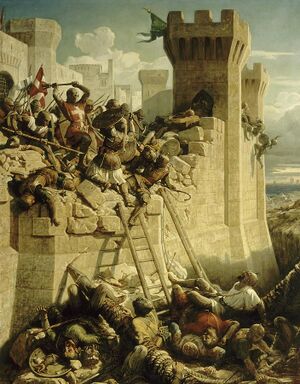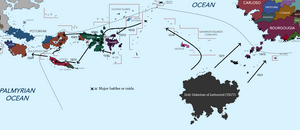Luttenried Crusade
This article is incomplete because it is pending further input from participants, or it is a work-in-progress by one author. Please comment on this article's talk page to share your input, comments and questions. Note: To contribute to this article, you may need to seek help from the author(s) of this page. |
| The Luttenried Crusade | ||||||||||
|---|---|---|---|---|---|---|---|---|---|---|
 Luttenried Order Knights furiously defend Werdheri Castle to the bitter end against Mujahideen forces, 1528. | ||||||||||
| ||||||||||
| Belligerents | ||||||||||
|
Musgorocian Coalition
|
United-Islands Mujahideen Front | |||||||||
| Commanders and leaders | ||||||||||
| Unknown | Unknown | ||||||||
| Units involved | ||||||||||
|
| Unknown. | Unknown. | ||||||||
| Strength | ||||||||||
| Unknown | Between 20,000 and 40,000 at the start of the war. Up to 120,000 at their height. Between 100 and 500 ships throughout the war. | ||||||||
| Casualties and losses | ||||||||||
| Unknown. | Between 20,000 and 60,000 total killed in action, missing in action, or dying/wounded from other causes related to the war. Up to 200 ships lost or captured. | ||||||||
| † Killed In Action. Although coopertive, Mujahideen Warlords and the Musgorocian Coalition dinstinctly remained neutral concerning the other party and were thus documented as different belligerents in the conflict. | ||||||||||
The "Luttenried Crusade(s)" (or "Luttenried War(s)") were a series of religious conflicts (Crusades) and imperialist military campaigns launched by the Luttenried Crusader State and Pontifical Diet for Wilhelmshaven against neighboring lands; The Empire of Common Territories, Luttenried's overlord, financially and militarily supported Luttenried throughout the war. Luttenried's key set of objectives throughout the Crusade was the capture of territory near its continent, convert or remove all heritics/blasphemers from the land, and incorporate that land into the Luttenried Crusader State. Materialist as much as they were religious, Luttenried believed that if their religious goals of spreading the faith and destroying its enemies through force were achieved, so too would their materialist desires; Luttenried desired more resources and a more prestigious title within the Empire, results that would naturally follow suit if Luttenried was able to double its territory. The Empire, although hesitant at first, threw the full force of its Luttenried stationed forces behind the Luttenried Order's Crusade - a victory for Luttenried was a victory for the Empire after all. Imperial goals throughout the entirety of the conflict were aimed at establishing control over more islands for which they could increase their presence by using Luttenried as a colonial overlord in their stead. Both the Kirche der Königlich and Pontifical Diet for Wilhelmshaven were in steadfast agreement that Crusades in Kali Yuga were necessary for spreading the faith along with defeating the enemies of the Kingdom of Heaven. Thus it was with their approval that a Crusade was decreed.
Calls for volunteers among the faithful throughout the Empire and Luttenried varied depending on the location. Many within the Empire, although enthustiastic, were more focused on fighting the pagans at home located in the southern Mainland. Colonials like Luttens were more eager to volunteer than those from the Mainland. Although few in comparison to the knights present in the Mainland, thousands still arrived during the Crusade to take up arms or provide assistance however they knew how. Luttens, however, had to be turned away, often by force, because too many of the men desired to go to war; having too many men join the Crusade would risk causing several disasters the Order simply wished to preemptively avoid. Since a large swath of the male population already served within the Luttenried Order as knights (all males were members of the Order in some regard), those that didn't serve as knights were technically part of home defense forces that were not expected to serve in actual combat unless the continent was directly attacked. These men were relegated to continuing their professions at home or joining industries that supported the Crusade. Being turned away did not stop some volunteers from using numerous methods to join regardless of the Order's denial for their service. A "Pilgrim Crusade" was illegally formed, ushering in the creation of numerous Crusader Knight Orders and military militias that took part in several battles during the Crusade until most were wiped out at the during or after the Battle of Nadenberg in 1520.
November 8th, 1510 is the recorded date used by historians to mark the beginning of the Crusade. It marks the day that a combined Luttenried and Imperial naval force launched their initial naval assault against major Bourgougia islands northeast of Luttenried. The following week, a second combined Luttenried and Imperial force sailed north, targeting the island of Vaotua and surrounding Spanish islands. In what would become the "Eastern Theater" lead by Olaf Rafael Luttenried, the Holy Duke's first son and heir, the "Eastern Campaign'" enjoyed an initial victory on the closest island to Luttenried now known as the Helfried Barondom. Caught off guard, the Bourgougians were not remotely prepared for the two dozen major warships and over twenty-five thousand soldiers that attacked their island. This would be the final "sweet victory" the Crusaders would enjoy against the Bourgougia, however. The second island attacked by the Crusaders, now the Othmar Barondom, is the largest island within the island chain under modern Luttenried control; the three Baronys are now overseen by the Holy Marquess of Klingewalde, a revived Barony House promoted after the Bourgougian Blitz. Initial attacks by General Adelbert Abraham Reier (leading the other half of the Eastern Campaign's over forty thousand soldiers) proved to be successful, but unlike Helfried, Othmar possessed a much larger garrison and quickly received reinforcements once news of the outbreak of war reached nearby islands. Evenly matched at times, and well motivated, the Bourgougia forces would prove to be a difficult opponent for the Crusaders and Imperials. So much so that hopes of taking the entire island chain by 1515 were dashed by the Battle of Wollau.
Meanwhile, in the "Western Theater" overseen by Günther Von Grimmelshausen's "Western Campaign," success-after-success became the norm for the first three years of the Crusade. Numbering somewhere in the forty thousand soldiers just like the Eastern Campaign, the Western Campaign blitzed through the northern islands. Vaotua, Grimmelshausen's first target, swiftly fell after a crushing victory over the more primitive natives during the Battle of Bosruck. Spanish islands surrounding Vaotua fell just as quickly due to the colonial administration's instability and their lightly garrisoned militias unprepared for serious combat. The Western Campaign finally met serious resistance after arriving to the muslim island nations located northwest of Luttenried in 1513. Prior to attacking the muslim states to the northwest, Grimmelshausen split his forces evenly between himself and General Elmar André Brose once the Western Campaign took over South Oceanica. While General Brose would lead the "2nd Western Army" against the island nations of Damar and Alor, Grimmelshausen himself would continue to lead the Western Campaign and the "1st Western Army" against Luttenried's closest major muslim neighbor, the nation of Sunda. Overconfident due to their three years of back-to-back successes, both armies were almost taken aback by the well organized and fiercely motivated muslim forces they now faced. The muslim island nations, hearing of Luttenried's Crusade against other islands near them, had began preparing after hearing stories of their initial assaults in 1511. Eastern nations within the chain of islands were sure Luttenried and the Imperials would reach their shores before too long, thus pleading the more western islands to send reinforcements before that could happen. Western nations doubted the Crusader's will to push further west than they already have, thus they largely choose to wait and see how the conflict would develop. After the invasions of Damar and Sunda in 1513, it was as if the muslim faith within the region had exploded with anger. Anger so deeply concentrated, the many pirate forces located throughout the region all joined the newly formed "United-Islands Mujahideen Front" instead of continuing their pirate operations. UIMF, made up of Mujahideen forces within each nation alongside their actual military forces, would launch their own Jihad aimed at liberating all muslim islands from Luttenried. Their long term goal however was to wipe out the Holy Duchy (and the Empire by extension) from Kali Yuga entirely. Creation and involvement of the UIMF would become the Western Campaign's first major escalation point similar to the Eastern Campaign's Battle of Wollau. From that point onward, Crusaders faced patriotic and similarly zealot Jihadi forces that only grew stronger year after year.

